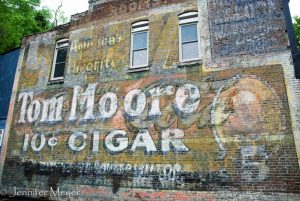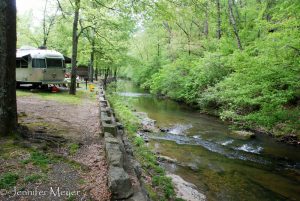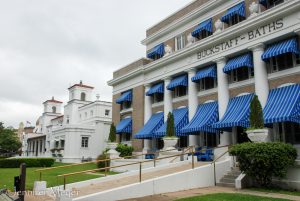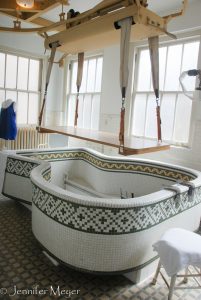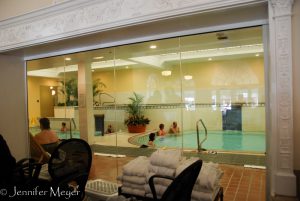In the late 1800s, Hot Springs was a hot-bed of health-craving tourism. Luxury bathhouses lined the main street, backing the steaming hot natural springs at the base of the area’s largest hill. People paid good money to come for a steaming bath in the odorless spring water, exercise, get massaged and coifed, and promenade among high society. In the late 1920s, casinos popped up and the city became famous for gambling and gangsters. Today the springs themselves are part of a national park, and one of the most luxurious bathhouses is a national park museum. Two of the original bathhouses are still in use, and the town still draws crowds of tourists.
Gulpha Gorge Campground
This nearby national park campground doesn’t take reservations, and we were lucky to get one of the last two open spots at 2:00. There are only 44 sites, nine of them “tent” sites, which mean no hook-ups, but there was plenty of space for Bessie. We chose a tent site over a water/electric site because it was by the river, and it was only $10/night.
The campground was such a sweet one. Well-maintained and quiet, with a nice amphitheater and fire pit, and trails crossing the river up into the hills. The rangers had a show for kids the night we were there, followed by a bonfire for roasting hot dogs and marshmallows. The campground is only a five-minute drive to downtown Hot Springs.
Bathhouse Row
When we first drove into Hot Springs from the west, we couldn’t imagine what the draw to this town was. All we saw were run-down homes and businesses. But Bathhouse Row is where it’s at. These few blocks of Central Avenue are where most tourists linger. There are the usual tourist shops and restaurants, hot spring fountains, and buggy rides. Two of the early bathhouses (Quapaw and Buckstaff) are still open for baths, massages, and other spa treatments. The Fordyce Bathhouse has been turned into the National Park Visitor Center and Museum. And there is a beautiful “promenade” walk on the hill behind Bathhouse Row.
Our one evening in Hot Springs, we walked all around the downtown area and ate dinner at an Indian/Pakistani restaurant. The Visitor Center was closed then, but we could tell it was not to be missed. So before we broke camp the next day, we came back in the morning for a tour.
Hot Springs Visitors Center
Housed in one of the town’s most luxurious old bathhouses (The Fordyce), the Visitor Center is now a free museum, showcasing bathhouse life in the late 1880s. You can wander freely through the three-story building, and each room is set up to demonstrate what it was like in the bathhouse heyday. You can see the men’s and women’s dressing rooms and parlors. The old baths and showers. Rooms for massage with what must be the earliest versions of vibrators and “TENS units.” Beauty parlors and barber shops. State rooms for taking a rest between activities. A gymnasium filled with trapezes, punching bags, and gymnastic bars. And a showcase of early physical therapy machines intended to help exercise (or batter) specific areas of the body.
This museum was fascinating and fun. I was pleased to see that it also addressed segregation. Although almost all of the bathhouse staff were African American, black visitors were restricted to their own less luxurious bathhouses in a different part of town.
Soaking Options
We wanted to experience the benefits of a natural spring soak ourselves, but unlike Oregon, you can’t hike a couple of miles through woods, strip off your optional clothes, and lower yourself into a steaming pool of spring-fed water. The hot spring pools here are all contained within the pristine walls of spendy bathhouses. We checked the prices at the Quapaw bathhouse. For $20 apiece, we could don our suits and sit in one of two tubs behind glass in the front lobby. That seemed pretty expensive to us. For $45, they offered a time-limited couples tub, and that might be more worth it, but they were already booked through the weekend. So ultimately, we saved our $40 and opted out of the “ultimate Hot Springs experience.”

